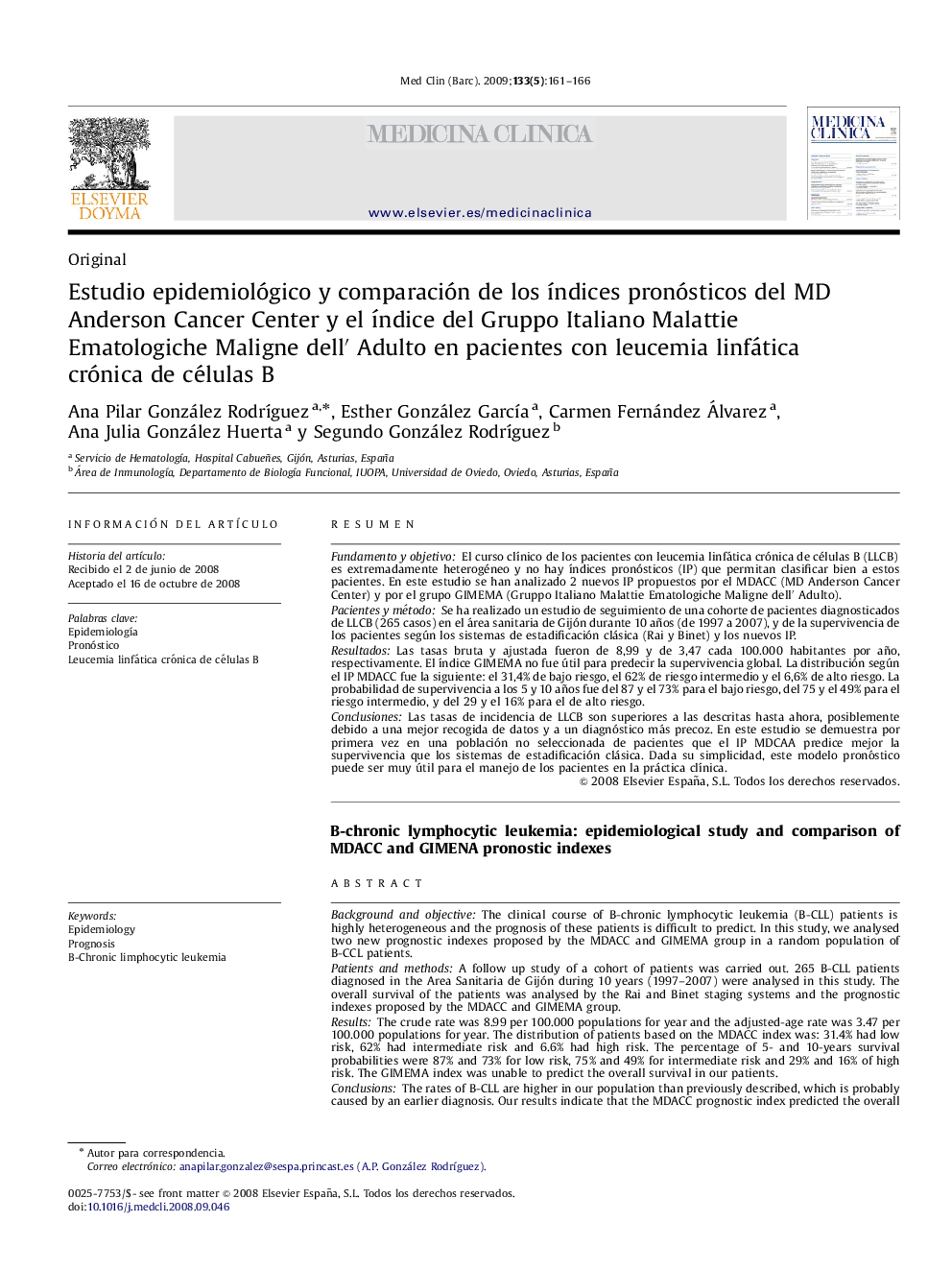| Article ID | Journal | Published Year | Pages | File Type |
|---|---|---|---|---|
| 3801007 | Medicina Clínica | 2009 | 6 Pages |
ResumenFundamento y objetivoEl curso clínico de los pacientes con leucemia linfática crónica de células B (LLCB) es extremadamente heterogéneo y no hay índices pronósticos (IP) que permitan clasificar bien a estos pacientes. En este estudio se han analizado 2 nuevos IP propuestos por el MDACC (MD Anderson Cancer Center) y por el grupo GIMEMA (Gruppo Italiano Malattie Ematologiche Maligne dell′ Adulto).Pacientes y métodoSe ha realizado un estudio de seguimiento de una cohorte de pacientes diagnosticados de LLCB (265 casos) en el área sanitaria de Gijón durante 10 años (de 1997 a 2007), y de la supervivencia de los pacientes según los sistemas de estadificación clásica (Rai y Binet) y los nuevos IP.ResultadosLas tasas bruta y ajustada fueron de 8,99 y de 3,47 cada 100.000 habitantes por año, respectivamente. El índice GIMEMA no fue útil para predecir la supervivencia global. La distribución según el IP MDACC fue la siguiente: el 31,4% de bajo riesgo, el 62% de riesgo intermedio y el 6,6% de alto riesgo. La probabilidad de supervivencia a los 5 y 10 años fue del 87 y el 73% para el bajo riesgo, del 75 y el 49% para el riesgo intermedio, y del 29 y el 16% para el de alto riesgo.ConclusionesLas tasas de incidencia de LLCB son superiores a las descritas hasta ahora, posiblemente debido a una mejor recogida de datos y a un diagnóstico más precoz. En este estudio se demuestra por primera vez en una población no seleccionada de pacientes que el IP MDCAA predice mejor la supervivencia que los sistemas de estadificación clásica. Dada su simplicidad, este modelo pronóstico puede ser muy útil para el manejo de los pacientes en la práctica clínica.
Background and objectiveThe clinical course of B-chronic lymphocytic leukemia (B-CLL) patients is highly heterogeneous and the prognosis of these patients is difficult to predict. In this study, we analysed two new prognostic indexes proposed by the MDACC and GIMEMA group in a random population of B-CCL patients.Patients and methodsA follow up study of a cohort of patients was carried out. 265 B-CLL patients diagnosed in the Area Sanitaria de Gijón during 10 years (1997–2007) were analysed in this study. The overall survival of the patients was analysed by the Rai and Binet staging systems and the prognostic indexes proposed by the MDACC and GIMEMA group.ResultsThe crude rate was 8.99 per 100.000 populations for year and the adjusted-age rate was 3.47 per 100.000 populations for year. The distribution of patients based on the MDACC index was: 31.4% had low risk, 62% had intermediate risk and 6.6% had high risk. The percentage of 5- and 10-years survival probabilities were 87% and 73% for low risk, 75% and 49% for intermediate risk and 29% and 16% of high risk. The GIMEMA index was unable to predict the overall survival in our patients.ConclusionsThe rates of B-CLL are higher in our population than previously described, which is probably caused by an earlier diagnosis. Our results indicate that the MDACC prognostic index predicted the overall survival and the prognosis of a random population of patients better than the classical staging systems. The simplicity and utility of this prognostic index may help clinicians in clinical decision and therapeutical management.
